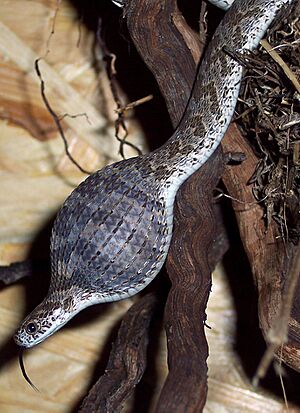Dasypeltis scabra facts for kids
Quick facts for kids Dasypeltis scabra |
|
|---|---|
 |
|
| D. scabra after swallowing an egg | |
| Conservation status | |
| Scientific classification | |
| Genus: |
Dasypeltis
|
| Species: |
scabra
|
| Synonyms | |
|
|
The common egg eater (also known as the egg-eating snake or rhombic egg eater) is a fascinating snake. Its scientific name is Dasypeltis scabra. This snake belongs to the Colubridae family. It is special because it lives only in Africa.
Contents
- Where Does the Egg-Eating Snake Live?
- What Does the Egg-Eating Snake Look Like?
- How Does the Egg-Eating Snake Protect Itself?
- Where Does the Egg-Eating Snake Live?
- How Does the Egg-Eating Snake Behave?
- What Does the Egg-Eating Snake Eat?
- How Does the Egg-Eating Snake Reproduce?
- Types of Egg-Eating Snakes
Where Does the Egg-Eating Snake Live?
The common egg eater snake is found in many parts of sub-Saharan Africa. This means the areas of Africa south of the Sahara Desert. You can also find it in Saudi Arabia and other countries in the Middle East.
What Does the Egg-Eating Snake Look Like?
This snake can grow to be about 40 to 46 inches (100 to 117 cm) long. That includes its tail! Its jaws have almost no teeth.
On its back, the snake has dark brown spots that look like diamonds. These spots are on a lighter background. It also has different brown spots on its sides. A clear V-shaped mark is found at the back of its neck. Its belly is usually yellowish. It might be plain or have dark dots.
How Does the Egg-Eating Snake Protect Itself?
The common egg eater snake is not venomous. But it can look a lot like other dangerous snakes! This trick is called mimicry.
For example, it looks very similar to the venomous saw-scaled viper (Echis carinatus). It also looks like the rhombic night adder (Causus rhombeatus).
You can often tell the difference by looking at their eyes. Egg-eating snakes have pupils that are like thin lines (vertical). Rhombic night adders have round pupils. However, in dark places, the egg eater's pupils can become round. So, this is not always the best way to tell them apart.
When the egg eater snake feels scared, it has a special defense. It can puff up its body to look bigger. It also makes a "hissing" sound. It does this by rubbing its rough scales together very fast. Then, it strikes with its mouth wide open, but it won't bite you.
Where Does the Egg-Eating Snake Live?
Dasypeltis scabra can live in many different places. It does not live in very thick forests. It also avoids true deserts. But it can be found in most other types of environments in between.
How Does the Egg-Eating Snake Behave?
The rhombic egg eater is a nocturnal animal. This means it is active mostly at night. Even though it usually stays on the ground, it is a great climber. It can climb on rocks and trees. It does this to find and raid birds' nests.
What Does the Egg-Eating Snake Eat?
This snake has a very special diet: it eats only eggs! Its mouth has small, bumpy ridges. These ridges are like human fingerprints. They help the snake hold onto the eggshell.
Once the snake swallows an egg, something amazing happens. Special bones in its spine poke the egg. These bones are called vertebral hypapophyses. They extend into the snake's throat. After the egg is punctured, the snake spits out the empty shell in one piece. The liquid inside the egg then goes into its stomach.
How Does the Egg-Eating Snake Reproduce?
The common egg eater lays eggs. This is called being oviparous. In the summer, a female snake can lay one or two groups of eggs. Each group can have 6 to 25 eggs. The eggs are about 1.4 inches long and 0.7 inches wide (36 x 18 mm). When the baby snakes hatch, they are about 8.3 to 9.4 inches (21–24 cm) long.
Types of Egg-Eating Snakes
There are two main types, or subspecies, of the common egg eater snake.
- Dasypeltis scabra loveridgei
- Dasypeltis scabra scabra
The name loveridgei honors a British scientist named Arthur Loveridge. He studied reptiles and amphibians.


